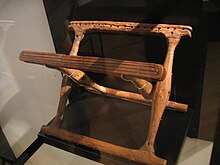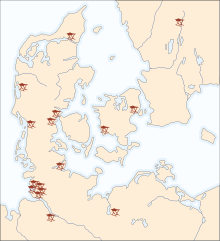
Furniture refers to objects intended to support various human activities such as seating, eating (tables), storing items, working, and sleeping. Furniture is also used to hold objects at a convenient height for work, or to store things. Furniture can be a product of design and can be considered a form of decorative art. In addition to furniture's functional role, it can serve a symbolic or religious purpose. It can be made from a vast multitude of materials, including metal, plastic, and wood. Furniture can be made using a variety of woodworking joints which often reflects the local culture.

A kurgan is a type of tumulus constructed over a grave, often characterized by containing a single human body along with grave vessels, weapons and horses. Originally in use on the Pontic–Caspian steppe, kurgans spread into much of Central Asia and Eastern, Southeast, Western and Northern Europe during the 3rd millennium BC.

A tumulus is a mound of earth and stones raised over a grave or graves. Tumuli are also known as barrows, burial mounds or kurgans, and may be found throughout much of the world. A cairn, which is a mound of stones built for various purposes, may also originally have been a tumulus.
The Tumulus culture was the dominant material culture in Central Europe during the Middle Bronze Age.
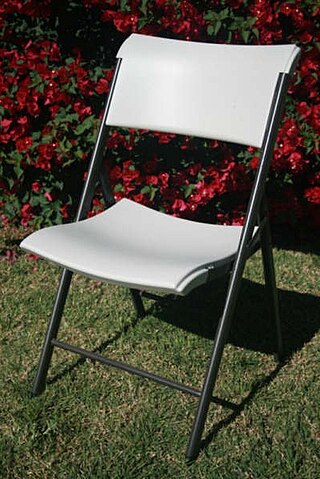
A folding chair is a type of folding furniture, a light, portable chair that folds flat or to a smaller size, and can be stored in a stack, in a row, or on a cart.

The Hochdorf Chieftain's Grave is a richly-furnished Celtic burial chamber near Hochdorf an der Enz in Baden-Württemberg, Germany, dating from 530 BC in the Hallstatt culture period. It was discovered in 1968 by an amateur archaeologist and excavated from 1978 to 1979. By then, the burial mound covering the grave, originally 6 m (20 ft) in height and about 60 m (200 ft) in diameter, had shrunk to about 1 m in height and was hardly discernible due to centuries of erosion and agricultural use.

The Vix Grave is a burial mound near the village of Vix in northern Burgundy. The broader site is a prehistoric Celtic complex from the Late Hallstatt and Early La Tène periods, consisting of a fortified settlement and several burial mounds.

Bush Barrow is a site of the early British Bronze Age Wessex culture, at the western end of the Normanton Down Barrows cemetery in Wiltshire, England. It is among the most important sites of the Stonehenge complex, having produced some of the most spectacular grave goods in Britain. It was excavated in 1808 by William Cunnington for Sir Richard Colt Hoare. The finds, including worked gold objects, are displayed at Wiltshire Museum in Devizes.

The Inariyama Kofun (稲荷山古墳) is a kofun burial mound located in the city of Gyōda, Saitama Prefecture, in the Kantō region of Japan. The tumulus was designated a National Historic Site in 1938 and re-designated as a Special National Historic Site of Japan in 2020 as part of the Sakitama Kofun Cluster. It is also referred to as the Sakitama Inariyama Kofun (埼玉稲荷山古墳) or the Gyōda Inariyama Kofun (行田稲荷山古墳) to disambiguate it from other tumuli using the name of "Inariyama" in other parts of the country.
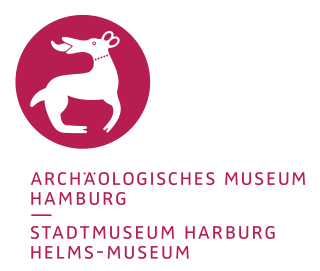
The Archäologisches Museum Hamburg is an archaeological museum in the Harburg borough of Hamburg, Germany. It houses the archaeological finds of the city of Hamburg and the neighbouring counties to the south of the city. It focuses on northern German prehistory and early history as well as the history of the former city of Harburg. The museum is also home to the cultural heritage landmarks commission of the city of Hamburg and the adjacent district of Harburg in Lower-Saxony and thus supervises all archaeological undertakings in the region.

The Sutton Hoo purse-lid is one of the major objects excavated from the Anglo-Saxon royal burial-ground at Sutton Hoo in Suffolk, England. The site contains a collection of burial mounds, of which much the most significant is the undisturbed ship burial in Mound 1 containing very rich grave goods including the purse-lid. The person buried in Mound 1 is usually thought to have been Rædwald, King of East Anglia, who died around 624. The purse-lid is considered to be "one of the most remarkable creations of the early medieval period." About seven and a half inches long, it is decorated with beautiful ornament in gold and garnet cloisonné enamel, and was undoubtedly a symbol of great wealth and status. In 2017 the purse-lid was on display at the British Museum.

The Tangendorf disc brooch is an Iron Age fibula from the 3rd century AD, which was dug up in 1930 from the sand of a Bronze Age tumulus near Tangendorf, Toppenstedt, Harburg, Lower Saxony, Germany. The front of the elaborately crafted garment fibula is decorated with a rear-facing four-legged animal, probably a dog or a deer. It is one of Harburg's most important finds from the period of the Roman Empire, and is in the permanent exhibition of the Archaeological Museum Hamburg in Harburg, Hamburg.

The Metzendorf-Woxdorf head of burial is the Neolithic burial of a single human skull that was found in 1958 in the Seevetal district of Woxdorf, in Harburg, in Lower Saxony. The find is currently the only one of its kind of the Single Grave Culture in Germany and is in the permanent exhibition of the Archaeological Museum Hamburg in Harburg, Hamburg.

The Maschen disc brooch is an Early Medieval fibula, which was found in 1958 during archaeological excavations of the late Saxon grave field near Maschen, in the Lower Saxony district of Harburg, Germany. On its face side, the fibula shows an unidentified saint with a halo. It was found in a woman's grave of the beginning of the Christianization of northern Germany, and is in the permanent exhibition of the Archaeological Museum Hamburg in Harburg, Hamburg.
Part of series of articles upon Archaeology of Kosovo

The Arioka Kofun Cluster is a group of kofun burial mounds located in the city of Zentsūji, Kagawa Prefecture, on the island of Shikoku of Japan. The tumuli were collectively designated a National Historic Site in 1984. It is claimed to be a group of tombs of the powerful local family who were the ancestors of the famed prelate Kūkai.

The Knowes of Trotty is a Bronze Age cemetery located in Mainland, Orkney in Scotland. The ancient site consists of a group of twelve surviving burial mounds, dating to 2030–1770 BC. Along with cremated human remains, four gold discs and a number of amber beads and pendants were discovered in the largest mound in 1858. Knowes of Trotty is one of the earliest group of burial mounds in Orkney and one of the largest Bronze Age cemeteries in the United Kingdom.
The Armorican Tumulus culture is a Bronze Age culture, located in the western part of the Armorican peninsula of France. It is known through more than a thousand burial sites covered by a tumulus or otherwise. The culture is renowned for some exceptionally richly endowed burials of chieftains of the time, which are contemporary with the elite of the Wessex culture, in England, and the Unetice culture, in Central Europe.
The Myōkensan Kofun (妙見山古墳) is a Kofun period burial mound, located in the Onishi neighborhood of the city of Imabari, Ehime on the island of Shikoku in Japan. It was designated a National Historic Site of Japan in 2010. It is the largest rectangular burial mound in Shikoku.
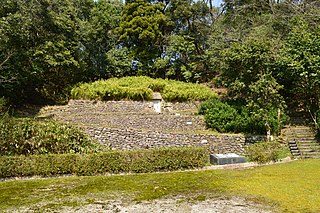
The Kajiyama Kofun (梶山古墳) is a Kofun period burial mound located in the Okamasu, Kokufucho, neighborhood of the city of Tottori, Tottori Prefecture in the San'in region of Japan. The tumulus was designated a National Historic Site of Japan in 1979.






